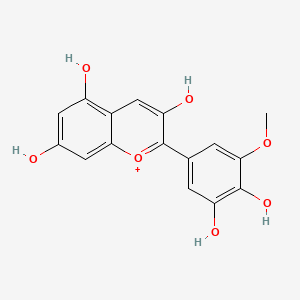| Authors | Title | Published | Journal | PubMed Link |
|---|---|---|---|---|
| Jayaprakasam B et al. | Insulin secretion by bioactive anthocyanins and anthocyanidins present in fruits. | 2005 | J. Agric. Food Chem. | pmid:15631504 |
| Lorenc-Kukuła K et al. | Glucosyltransferase: the gene arrangement and enzyme function. | 2004 | Cell. Mol. Biol. Lett. | pmid:15647808 |
| Zhang Y et al. | Human tumor cell growth inhibition by nontoxic anthocyanidins, the pigments in fruits and vegetables. | 2005 | Life Sci. | pmid:15680311 |
| Longo L et al. | Identification of anthocyanins in Rhamnus alaternus L. berries. | 2005 | J. Agric. Food Chem. | pmid:15740065 |
| Jang YP et al. | Anthocyanins protect against A2E photooxidation and membrane permeabilization in retinal pigment epithelial cells. | 2005 May-Jun | Photochem. Photobiol. | pmid:15745429 |
| Wu X and Prior RL | Systematic identification and characterization of anthocyanins by HPLC-ESI-MS/MS in common foods in the United States: fruits and berries. | 2005 | J. Agric. Food Chem. | pmid:15796599 |
| Wu X and Prior RL | Identification and characterization of anthocyanins by high-performance liquid chromatography-electrospray ionization-tandem mass spectrometry in common foods in the United States: vegetables, nuts, and grains. | 2005 | J. Agric. Food Chem. | pmid:15826066 |
| Flamini R | Some advances in the knowledge of grape, wine and distillates chemistry as achieved by mass spectrometry. | 2005 | J Mass Spectrom | pmid:15954164 |
| McDougall GJ et al. | Anthocyanins from red wine--their stability under simulated gastrointestinal digestion. | 2005 | Phytochemistry | pmid:16242736 |
| Garcia-Alonso M et al. | Electron spin resonance spectroscopy studies on the free radical scavenging activity of wine anthocyanins and pyranoanthocyanins. | 2005 | Mol Nutr Food Res | pmid:16254886 |
Petunidin
Petunidin is a lipid of Polyketides (PK) class. Petunidin is associated with abnormalities such as Vitamin A Deficiency, Night Blindness, Blind Vision, Chronic Disease and Heart Diseases. The involved functions are known as Drug Interactions, selective breeding, Signal Transduction, Protective Agents and Evolution. Petunidin often locates in Membrane, Body tissue, Gastrointestinal tract structure, Blood and Hepatic. The associated genes with Petunidin are TP53 gene, Genome and Genome, Human. The related lipids are Steroids and Total cholesterol. The related experimental models are Knock-out, Disease model and Animal Disease Models.
Cross Reference
Introduction
To understand associated biological information of Petunidin, we collected biological information of abnormalities, associated pathways, cellular/molecular locations, biological functions, related genes/proteins, lipids and common seen animal/experimental models with organized paragraphs from literatures.
What diseases are associated with Petunidin?
Petunidin is suspected in Chronic Disease, Obesity, Diabetes Mellitus, Non-Insulin-Dependent, Vitamin A Deficiency, Night Blindness, Blind Vision and other diseases in descending order of the highest number of associated sentences.
Related references are mostly published in these journals:
| Disease | Cross reference | Weighted score | Related literature |
|---|
No disease MeSH terms mapped to the current reference collection.
PubChem Associated disorders and diseases
What pathways are associated with Petunidin
There are no associated biomedical information in the current reference collection.
PubChem Biomolecular Interactions and Pathways
Link to PubChem Biomolecular Interactions and PathwaysWhat cellular locations are associated with Petunidin?
Visualization in cellular structure
Associated locations are in red color. Not associated locations are in black.
Related references are published most in these journals:
| Location | Cross reference | Weighted score | Related literatures |
|---|
What functions are associated with Petunidin?
Related references are published most in these journals:
| Function | Cross reference | Weighted score | Related literatures |
|---|
What lipids are associated with Petunidin?
Related references are published most in these journals:
| Lipid concept | Cross reference | Weighted score | Related literatures |
|---|
What genes are associated with Petunidin?
Related references are published most in these journals:
| Gene | Cross reference | Weighted score | Related literatures |
|---|
What common seen animal models are associated with Petunidin?
Knock-out
Knock-out are used in the study 'How can research on plants contribute to promoting human health?' (Martin C et al., 2011).
Disease model
Disease model are used in the study 'How can research on plants contribute to promoting human health?' (Martin C et al., 2011).
Animal Disease Models
Animal Disease Models are used in the study 'How can research on plants contribute to promoting human health?' (Martin C et al., 2011).
Related references are published most in these journals:
| Model | Cross reference | Weighted score | Related literatures |
|---|
